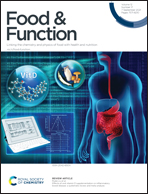A systematic assessment of structural heterogeneity and IgG/IgE-binding of ovalbumin†
Abstract
Ovalbumin (OVA), one of the major allergens in hen egg, exhibits extensive structural heterogeneity due to a range of post-translational modifications (PTMs). However, analyzing the structural heterogeneity of native OVA is challenging, and the relationship between heterogeneity and IgG/IgE-binding of OVA remains unclear. In this work, ion exchange chromatography (IXC) with salt gradient elution and on-line detection by native electrospray ionization mass spectrometry (ESI MS) was used to assess the structural heterogeneity of OVA, while inhibition-ELISA was used to assess the IgG/IgE binding characteristics of OVA. Over 130 different OVA proteoforms (including glycan-free species and 32 pairs of isobaric species) were identified. Proteoforms with acetylation, phosphorylation, oxidation and succinimide modifications had reduced IgG/IgE binding capacities, whereas those with few structural modifications had higher IgG/IgE binding capacities. OVA isoforms with a sialic acid-containing glycan modification had the highest IgG/IgE binding capacity. Our results demonstrate that on-line native IXC/MS with salt gradient elution can be used for rapid assessment of the structural heterogeneity of proteins. An improved understanding of the relationship between IgG/IgE binding capacity and OVA structure provides a basis for developing biotechnology or food processing methods for reducing protein allergenicity reduction.



 Please wait while we load your content...
Please wait while we load your content...
